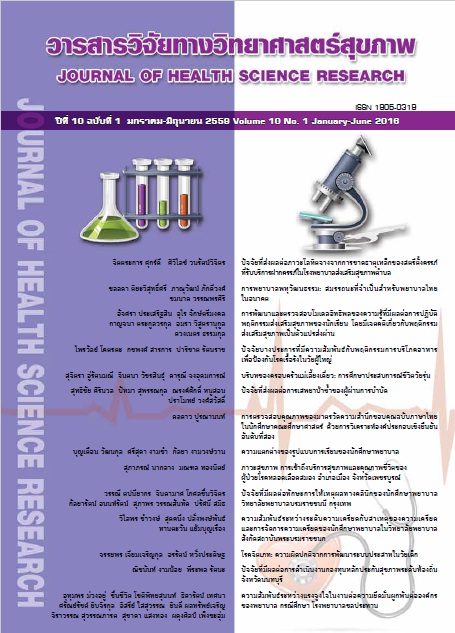ความแตกต่างของรูปแบบการเรียนของนักศึกษาพยาบาล
Main Article Content
บทคัดย่อ
บทคัดย่อ
การวิเคราะห์รูปแบบการเรียนของผู้เรียนเป็นปัจจัยสำคัญต่อการออกแบบการเรียนรู้ให้สอดคล้องกับลักษณะของผู้เรียน
การวิจัยภาคตัดขวางครั้งนี้มีวัตถุประสงค์เพื่อศึกษาความแตกต่างของรูปแบบการเรียนในนักศึกษาพยาบาล กลุ่มตัวอย่าง คือ นักศึกษา
พยาบาลทุกชั้นปีของวิทยาลัยพยาบาลบรมราชชนนี ชลบุรี จำนวน 463 คน เครื่องมือในการวิจัย คือ แบบสอบถามรูปแบบการเรียน
แบบ VARK คำถามเกี่ยวกับรูปแบบการเรียนจำนวน 16 ข้อ แต่ละข้อคำถามมี 4 ตัวเลือก ประกอบด้วย การดู (Visual Learners) การฟัง (Aural Learners) การอ่าน-เขียน (Read/Write Learners) และการปฏิบัติ (Kinesthetic Learners)
ผลการวิจัยพบว่า การเรียนรู้จากการดูและการอ่าน-เขียนเป็นรูปแบบการเรียนแบบที่นักศึกษาส่วนมากชอบและ นักศึกษาชอบ
การเรียนรู้หลากหลายรูปแบบ (Multimodality) คิดเป็น 67% โดยนักศึกษาจะชอบการอ่าน-เขียน ผสมผสานกับการดูและการปฏิบัติ ร่วมด้วย และนักศึกษา > 30% มีรูปแบบการเรียนเป็น Single preference แต่ละชั้นปีมีรูปแบบ Multimodal learning preference มากกว่า Single learning preference และการเปรียบเทียบความแตกต่างของรูปแบบการเรียนระหว่างชั้นปีด้วย ANOVA และ Bonferroni adjustment พบความแตกต่างอย่างมีนัยสำคัญทางสถิติ (p < 0.001) โดยรูปแบบการเรียนของชั้นปีที่ 1 แตกต่างจากชั้นปีที่ 2 (p < 0.001) ชั้นปีที่ 2 มีรูปแบบการเรียนแตกต่างจากชั้นปีที่ 1, 3 และ 4 อย่างมีนัยสำคัญทางสถิติ (p < 0.001) รูปแบบการเรียนของนักศึกษาพยาบาลแตกต่างกันอย่างชัดเจนระหว่างชั้นปีที่ 1 ถึงชั้นปีที่ 3 การประเมินรูปแบบการเรียนและการปรับรูปแบบการสอนให้สอดคล้องกับความถนัดของผู้เรียนเป็นปัจจัยสำคัญในการจัดการเรียนรู้ที่มีประสิทธิภาพสัมฤทธิ์ผลตามวัตถุประสงค์ของหลักสูตร
Abstract
Learning preference of nursing students should be addressed to help instructors develop teaching
strategies to encourage effective learning. This cross-sectional study was aimed to examine whether there were differences in learning styles between academic years of nursing students or not.
A total of 463 nursing students was purposively selected from Boromarajonani College of Nursing Chonburi by four academic levels. Samples had completed the 16-item VARK questionnaire with 4 multiple-choices; choices consisted of modalities of Visual, Aural, Read/write, and Kinesthetic.Students reported higher preferences on visual and read/write. Almost 67% of students classified their learning preference as multimodalities; visual learning with read/write or kinesthetic preference. The multimodalities were greater than single preference in each academic level. Over 30% of students had one dominant preference of VARK learning styles. Analysis of Variance with Bonferroni adjustment revealed significant differences of learning styles by academic levels (p < 0.001). Learning styles were significant by different between first and the second-grade nursing
students (p < 0.001). Learning styles of the 2nd-grade nursing students differed significantly from those of the 1st, 3rd, and 4th grade nursing students (p < 0.001).Learning preferences of nursing students were higherm multimodalities and learning styles differed between academic years. Nursing instructors should design teaching methods to match with learning styles of nursing students.
Downloads
Article Details
บทความที่ได้รับการตีพิมพ์เป็นลิขสิทธิ์ของวิทยาลัยพยาบาลบรมราชชนนี จังหวัดนนทบุรี
ข้อความที่ปรากฏในบทความแต่ละเรื่องในวารสารวิชาการเล่มนี้เป็นความคิดเห็นส่วนตัวของผู้เขียนแต่ละท่านไม่เกี่ยวข้องกับวิทยาลัยพยาบาลบรมราชชนนี จังหวัดนนทบุรี และคณาจารย์ท่านอื่น ในวิทยาลัยฯ แต่อย่างใด ความรับผิดชอบองค์ประกอบทั้งหมดของบทความแต่ละเรื่องเป็นของผู้เขียนแต่ละท่าน หากมีความผิดพลาดใด ๆ ผู้เขียนแต่ละท่านจะรับผิดชอบบทความของตนเองแต่ผู้เดียว


